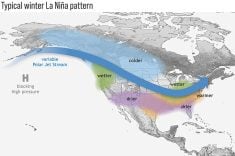Pickup truck drivers and passengers are the least safety-conscious in the prairie provinces when it comes to seat belts.
National surveys of seat belt use show up to a quarter of all truck occupants – usually rural residents – are not buckling up. And that means they are more likely to be injured or die in accidents.
In a Canadian survey of 81,768 vehicles at 241 locations done in June 1998, light truck drivers had their belts on 81.1 percent of the time compared to 90.6 percent of all van drivers and 91.5 percent of all car drivers.
Read Also

Canadian Food Inspection Agency extends chronic wasting disease control program consultation deadline
Date extended for consultation period of changes to CWD program
It is a $75 ticket for drivers or passengers not belted in, said Sgt. Bill Sterling of the Saskatoon RCMP detachment. He said the excuses police often hear from farmers about not wearing seat belts are because they are in a hurry at seeding or harvest or because they are driving a short distance between fields. Many also were probably driving 20 years ago before seat belts became compulsory, said Sterling. It has to become a habit to do up a belt, just like brushing one’s teeth, he said.
Saskatchewan drivers and passengers are more willing to buckle up than those in Manitoba or Alberta. However, even in the most obedient province, there is a gap between car and truck drivers, 93.9 to 84 percent.
More startling is Saskatchewan’s fatality rate for the first nine months of 1998. It shows 39 of 40 crashes, where there were deaths and seat belts were not used, were in rural areas.
Going back to 1995, Saskatchewan Government Insurance numbers show 143 people died in accidents when not wearing seat belts. Almost 92 of those deaths occurred in rural Saskatchewan and almost half of those who died were driving pickup trucks, said Kwei Quaye, manager of SGI’s traffic safety program evaluation.
Manitoba has improved its seat belt usage rate with year-round safety advertising and a program called Click in to Win, said Darryl Hammond of the Manitoba Public Insurance Corp.
In a three-year partnership between the province’s auto dealers and the RCMP, the police hand out cards for a chance to win a truck whenever they stop a vehicle and everyone in it is wearing a belt. Hammond said this is a popular program and rural people have won every year. Meanwhile the pickup truck drivers and passengers have increased their belt use by 15 percent, versus three percent for city drivers.
Deaths and injuries have also decreased since Manitoba began its road safety program, said Hammond. From 1990 to 1992 there were 128 deaths and 13,355 injuries.
The department said for 1996-1998, there were 104 deaths and 8,384 injuries.
Alberta seat belt use is about the same as Manitoba’s for car and van occupants but slightly worse for trucks. The provincial transport department said its 1997 injury statistics show seat belt users had half the chance of injury in accidents, at 14.7 percent, than those not using restraints, 35.7 percent.
Also, Albertans not wearing seat belts were 20 times more likely to die in an accident, 0.1 versus 2.1 percent.














